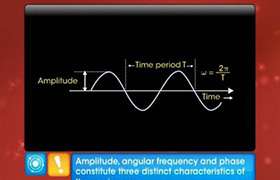CBSE Class 12-science Answered
Analytically explain the process of amplitude modulation. What is the frequency spectrum of AM signal?
Asked by Topperlearning User | 08 Jul, 2014, 12:59: PM
Let the carrier wave be represented by c(t)= Ac sin ωCt [ A c - Amplitude of carrier wave ]
and the information message (modulating wave) may be represented as
m(t) = A m sin ωm t [ A m -Amplitude of modulating wave]
where frequencies of the carrier wave and the message are ![]() and
and ![]() and νc and νm are their respective frequencies.
and νc and νm are their respective frequencies.
In Amplitude Modulation the amplitude of the carrier wave is controlled by modulating message, hence the modulated signal cm(t) may be written as

Here  are respectively known as the lower side and the upper side band frequencies. So, it is clear that now the modulated signal consists of the original carrier wave of angular frequency
are respectively known as the lower side and the upper side band frequencies. So, it is clear that now the modulated signal consists of the original carrier wave of angular frequency  plus two sinusoidal waves each with a frequency slightly different from
plus two sinusoidal waves each with a frequency slightly different from  and amplitude
and amplitude  each.
each.

This difference in frequency components are known as the bands. The frequency spectrum of AM signal is shown in the figure above.
Answered by | 08 Jul, 2014, 02:59: PM
Concept Videos
CBSE 12-science - Physics
Asked by sagarmishra | 08 Sep, 2023, 01:55: PM
CBSE 12-science - Physics
Asked by tanyagupta1874 | 17 Jan, 2022, 10:16: PM
CBSE 12-science - Physics
Asked by cupatil | 07 Mar, 2018, 11:22: PM
CBSE 12-science - Physics
Asked by Topperlearning User | 08 Jul, 2014, 09:23: AM
CBSE 12-science - Physics
Asked by Topperlearning User | 08 Jul, 2014, 09:45: AM
CBSE 12-science - Physics
Asked by Topperlearning User | 08 Jul, 2014, 10:05: AM
CBSE 12-science - Physics
Asked by Topperlearning User | 08 Jul, 2014, 10:36: AM
CBSE 12-science - Physics
Asked by Topperlearning User | 08 Jul, 2014, 11:00: AM
CBSE 12-science - Physics
Asked by Topperlearning User | 08 Jul, 2014, 11:14: AM
CBSE 12-science - Physics
Asked by Topperlearning User | 08 Jul, 2014, 11:23: AM




